The Best Crabapple Tree Varieties to Plant in Your Garden
Published: November 21, 2025 at 11:34:09 PM UTC
Flowering crabapple trees are among the most versatile and rewarding additions to any landscape. With their spectacular spring blossoms, colorful fruits that persist through winter, and attractive growth habits, these ornamental trees offer year-round interest while requiring minimal maintenance. Whether you're looking to attract wildlife, add seasonal color, or create a focal point in your garden, the right crabapple variety can transform your outdoor space with its beauty and resilience.
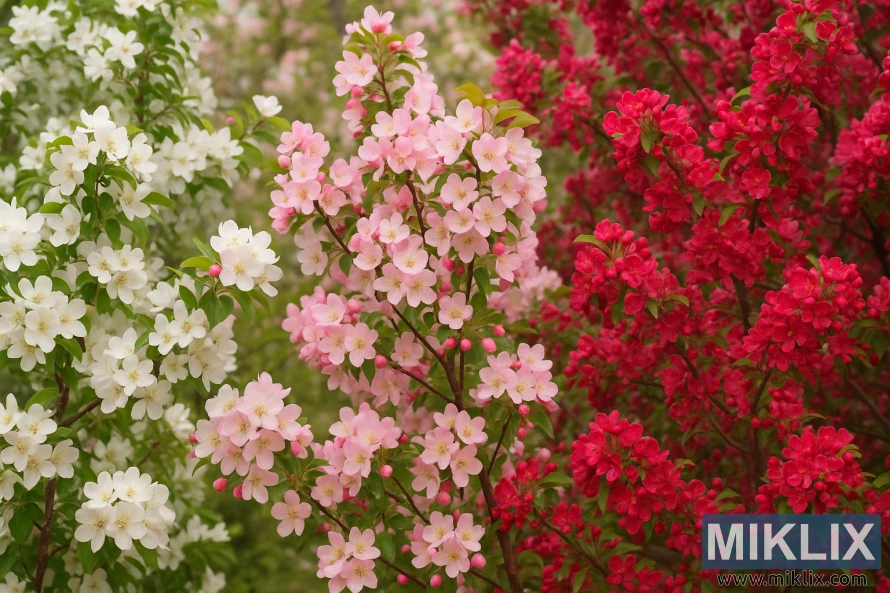
In this comprehensive guide, we'll explore the finest crabapple tree varieties available today, comparing their unique characteristics and helping you select the perfect tree for your specific garden needs. From compact varieties ideal for small spaces to disease-resistant cultivars that thrive with little attention, you'll discover why crabapples have earned their place as one of the most beloved ornamental trees for home landscapes.
Crabapple trees offer spectacular spring displays with blossoms ranging from pure white to deep pink
Why Crabapple Trees Deserve a Place in Your Garden
Before diving into specific varieties, let's explore what makes crabapple trees such excellent choices for home landscapes. These versatile trees offer multiple seasons of interest and numerous practical benefits:
Ornamental Value
- Spectacular spring blossoms in white, pink, or red
- Colorful fruits that persist through fall and winter
- Attractive foliage, with some varieties offering purple or bronze leaves
- Interesting branch structure visible in winter
- Compact size suitable for most garden spaces
Practical Benefits
- Excellent pollinators for apple trees
- Attract birds and wildlife with persistent fruits
- Disease-resistant varieties require minimal maintenance
- Adaptable to various soil conditions
- Fruits can be used for making jellies and preserves
- Many crabapple varieties retain their colorful fruits well into winter, providing food for birds

Comparing the Best Crabapple Tree Varieties
The following table compares key characteristics of our top recommended crabapple varieties, helping you quickly identify which might be best suited for your garden needs. Consider factors like mature size, flower color, fruit characteristics, and disease resistance when making your selection.
| Variety | Mature Size | Flower Color | Fruit Characteristics | Disease Resistance | Best Zones |
| Sargent | 8-10' tall, 10-15' wide | White | Small (¼") bright red, persistent | Excellent (scab, fire blight) | 4-8 |
| Prairiefire | 15-20' tall, 15-20' wide | Deep pink to red | Small (½") dark red, persistent | Excellent (scab, good fire blight) | 4-8 |
| Sugar Tyme | 15-20' tall, 12-15' wide | White | Small (½") bright red, persistent | Excellent (scab, good fire blight) | 4-8 |
| Royal Raindrops | 15-20' tall, 15' wide | Magenta pink | Small (¼") red, persistent | Excellent (scab, fire blight) | 4-8 |
| Adirondack | 15-18' tall, 10-12' wide | White | Small (½") bright orange-red | Excellent (scab, fire blight) | 4-8 |
| Harvest Gold | 18-20' tall, 15' wide | White | Small (⅜") golden yellow, persistent | Good (scab, moderate fire blight) | 4-8 |
| Red Jewel | 12-15' tall, 10' wide | White | Small (½") bright red, highly persistent | Good (scab, moderate fire blight) | 4-7 |
| Louisa | 12-15' tall, 15' wide | Pink | Small (⅜") gold-yellow | Good (scab, fire blight) | 4-8 |
| Spring Snow | 20-25' tall, 15-20' wide | White | Fruitless | Moderate (susceptible to scab) | 4-8 |
| Professor Sprenger | 20' tall, 20' wide | White | Medium (½") orange-red | Good (scab, moderate fire blight) | 4-8 |
Detailed Profiles of Top Crabapple Varieties
Let's take a closer look at our top recommended crabapple varieties, exploring their unique characteristics and specific garden applications.
Sargent Crabapple (Malus sargentii)
Growth Habits and Size
The Sargent crabapple is a dwarf variety, growing only 8-10 feet tall with a wider spread of 10-15 feet. Its distinctive horizontal branching pattern creates an attractive architectural element in the landscape. This slow-growing tree develops a dense, somewhat shrubby habit that works beautifully in smaller gardens.
Seasonal Interest
- Spring: Abundant pure white flowers bloom in dense clusters
- Summer: Dense, dark green foliage creates a neat, rounded form
- Fall: Small (¼") bright red fruits persist well into winter
- Winter: Horizontal branching pattern provides visual interest
Planting and Care Requirements
Sargent crabapple thrives in full sun but tolerates light shade. It adapts to various soil types as long as drainage is good. Once established, it's drought tolerant and requires minimal pruning. Its natural compact form means little maintenance is needed to maintain its shape.
Disease Resistance
This variety offers excellent resistance to apple scab and good resistance to fire blight, making it one of the most disease-resistant crabapples available. Its robust health means you'll spend less time treating problems and more time enjoying its beauty.
Landscape Uses
Perfect for small gardens, foundation plantings, or as a specimen tree. Its horizontal branching makes it ideal for planting on slopes or near water features. The persistent fruits attract birds throughout winter, adding wildlife interest to your garden.

Prairiefire Crabapple (Malus 'Prairiefire')
Growth Habits and Size
Prairiefire grows to a moderate 15-20 feet in both height and width, developing a rounded, symmetrical form. Its upright growth habit in youth gradually spreads with age, creating a balanced canopy that provides excellent shade while maintaining a compact footprint suitable for most garden spaces.
Seasonal Interest
- Spring: Deep pink to red flowers emerge from darker red buds
- Summer: New foliage emerges with a purple tint before maturing to dark green
- Fall: Small (½") dark red fruits persist well into winter
- Winter: Attractive branching structure and persistent fruits
Planting and Care Requirements
Plant in full sun for best flowering and fruit production. Adapts to various soil conditions but prefers well-drained, slightly acidic soil. Requires minimal pruning except to remove damaged branches or shape as desired. Water regularly during establishment; drought-tolerant once established.
Disease Resistance
Prairiefire offers outstanding resistance to apple scab and good resistance to fire blight and cedar-apple rust. This exceptional disease resistance makes it a low-maintenance choice that will maintain its beauty without extensive chemical treatments.
Landscape Uses
Excellent as a specimen tree, in mixed borders, or as part of a wildlife garden. The vibrant spring flowers and persistent fruits make it a focal point in any landscape. Its moderate size works well in suburban yards and public spaces.
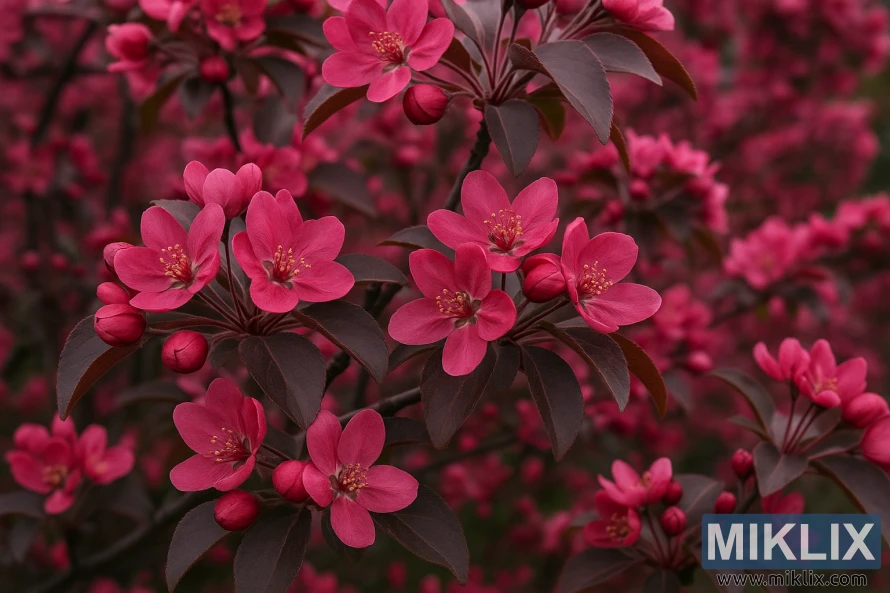
Royal Raindrops Crabapple (Malus 'Royal Raindrops')
Growth Habits and Size
Royal Raindrops reaches 15-20 feet tall with a 15-foot spread, forming an upright, somewhat pyramidal shape when young that becomes more rounded with age. Its growth rate is moderate, adding about 1-2 feet per year until reaching maturity.
Seasonal Interest
- Spring: Vibrant magenta-pink flowers create a spectacular display
- Summer: Distinctive purple, deeply-cut foliage maintains color throughout the season
- Fall: Foliage turns orange-red; small red fruits persist into winter
- Winter: Architectural branching pattern and persistent fruits add interest
Planting and Care Requirements
Plant in full sun to maximize purple foliage color and flowering. Adapts to various soil types but performs best in well-drained, moderately fertile soil. Requires minimal pruning and is drought-tolerant once established. Annual mulching helps retain soil moisture and suppress weeds.
Disease Resistance
Excellent resistance to apple scab, fire blight, cedar-apple rust, and powdery mildew makes Royal Raindrops one of the most disease-resistant crabapples available. This superior disease package ensures a healthy, attractive tree with minimal maintenance.
Landscape Uses
Makes an outstanding specimen tree with its purple foliage providing contrast in the landscape. Works well in mixed borders, as a street tree, or as a focal point in residential gardens. The persistent fruits attract birds throughout winter.

Planting and Care Tips for Crabapple Trees
Proper planting and ongoing care are essential for ensuring your crabapple tree thrives and provides years of beauty in your landscape. Follow these guidelines to get the most from your tree.
Proper planting depth is crucial for crabapple trees - ensure the root flare is visible at soil level
Soil Requirements and Sunlight Needs
Crabapple trees perform best in well-drained, moderately fertile soil with a pH between 5.5 and 6.5. While they can adapt to various soil types, they won't tolerate wet, poorly drained conditions. For optimal flowering and fruit production, plant your crabapple in a location that receives at least 6 hours of direct sunlight daily.
Planting Instructions
- Dig a hole twice as wide as the root ball but no deeper than the root ball height
- Remove the tree from its container and gently loosen the roots
- Position the tree so the root flare (where trunk widens at base) is visible at soil level
- Backfill with native soil, avoiding amendments in the planting hole
- Water thoroughly and apply 2-3 inches of mulch in a ring, keeping it away from the trunk
- Stake only if necessary in very windy locations, removing stakes after one year
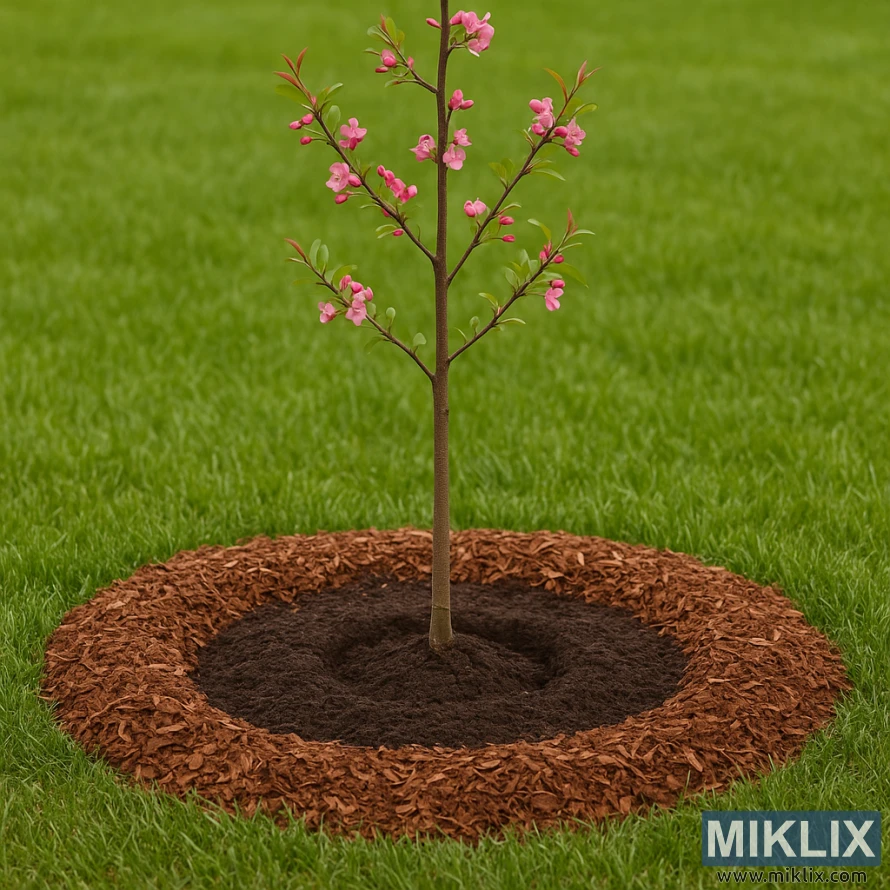
Pruning Guidelines
Crabapples require minimal pruning to maintain their natural form. The best time to prune is in late winter or early spring before new growth begins. Focus on:
- Removing dead, damaged, or diseased branches
- Eliminating crossing or rubbing branches
- Thinning crowded areas to improve air circulation
- Removing suckers from the base of the tree
- Shaping only as needed to maintain the tree's natural form
Common Problems and Solutions
Prevention Tips
- Choose disease-resistant varieties
- Ensure good air circulation around the tree
- Clean up fallen leaves and fruits
- Avoid overhead watering
- Maintain proper tree nutrition
Common Issues
- Apple scab (leaf spots, early defoliation)
- Fire blight (blackened branch tips)
- Cedar-apple rust (orange spots on leaves)
- Japanese beetles (leaf skeletonization)
- Aphids (sticky leaves, curled new growth)
Seasonal Care Calendar for Crabapple Trees
Follow this seasonal care calendar to ensure your crabapple tree remains healthy and beautiful throughout the year.
Spring
Care Tasks
- Apply slow-release fertilizer in early spring
- Refresh mulch layer (2-3 inches)
- Water deeply during dry periods
- Monitor for early pest activity
What to Watch For
- Fire blight symptoms during bloom
- Aphid infestations on new growth
- Cedar-apple rust development
Summer
Care Tasks
- Water during extended dry periods
- Remove any water sprouts or suckers
- Monitor for pest activity
What to Watch For
- Japanese beetle damage
- Apple scab symptoms
- Leaf spot diseases
Fall
Care Tasks
- Clean up fallen leaves and fruits
- Reduce watering as tree enters dormancy
- Apply protective trunk wrap if needed
What to Watch For
- Early leaf drop (disease indicator)
- Fruit development and ripening
- Rodent activity around base
Winter
Care Tasks
- Prune during late winter dormancy
- Protect from animal damage
- Plan for spring fertilization
What to Watch For
- Snow or ice damage to branches
- Bark damage from animals
- Fruit persistence for winter interest
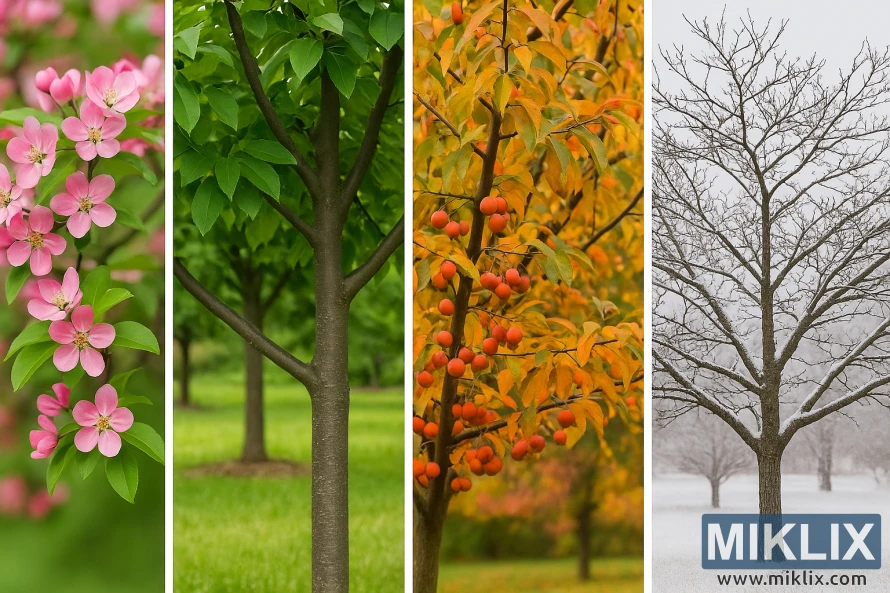
Design Ideas for Incorporating Crabapple Trees in Your Garden
Crabapple trees are incredibly versatile landscape elements that can enhance various garden styles. Here are some creative ways to incorporate these beautiful trees into your outdoor space.
Focal Point Planting
Plant a single specimen crabapple in a prominent location where its seasonal beauty can be appreciated. Consider varieties with outstanding features like Royal Raindrops for purple foliage or Harvest Gold for yellow fruits. Underplant with spring bulbs for a coordinated display.

Wildlife Garden
Create a bird-friendly landscape by incorporating varieties with persistent small fruits like Sargent, Red Jewel, or Sugar Tyme. Combine with other wildlife-supporting plants like serviceberry, dogwood, and native perennials to create a year-round habitat garden.

Small Space Solutions
For urban gardens, patios, or courtyards, choose compact varieties like Sargent (8-10' tall) or columnar forms like Adirondack. These smaller selections provide all the beauty of larger crabapples while fitting comfortably in restricted spaces. Consider growing in large containers for even more flexibility.
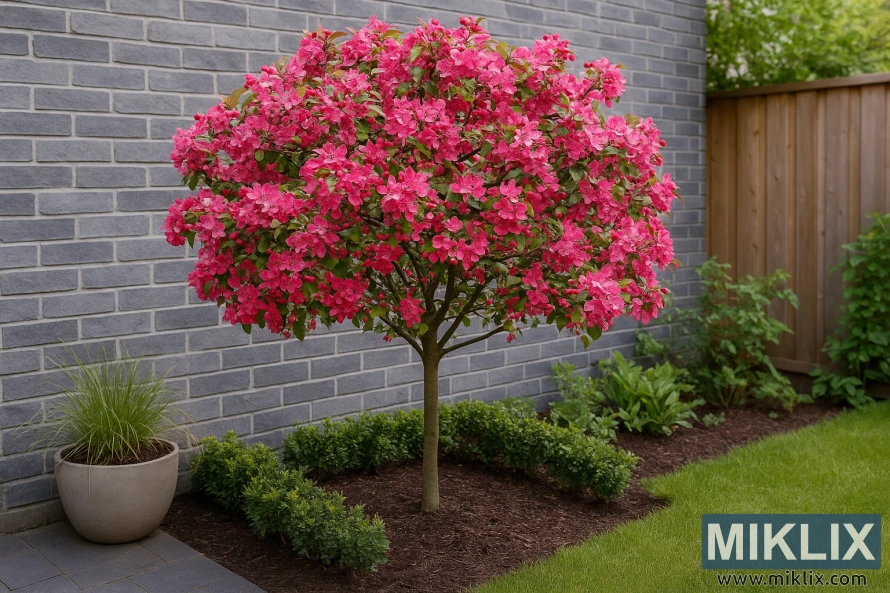
Mixed Border Integration
Incorporate crabapples into mixed borders where they can provide structure and vertical interest among perennials and shrubs. Their relatively small size makes them ideal "trees for perennial borders." Consider varieties with special foliage color like Royal Raindrops to add another dimension to your planting scheme.
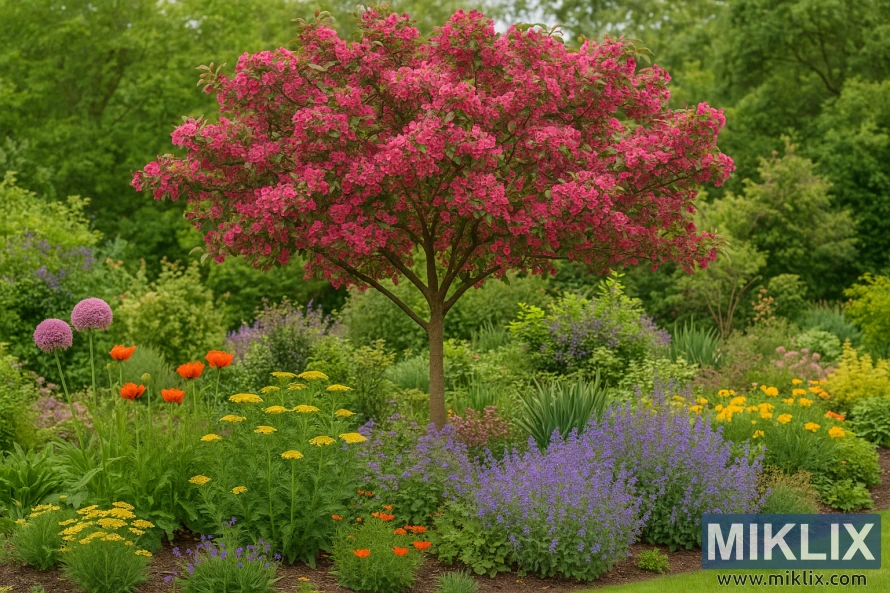
Orchard Aesthetic
Plant several crabapples in a loose grid to create a decorative mini-orchard. Mix varieties with different flower colors or bloom times to extend the seasonal display. This approach works beautifully in larger suburban lots where the trees can be appreciated as a collection.
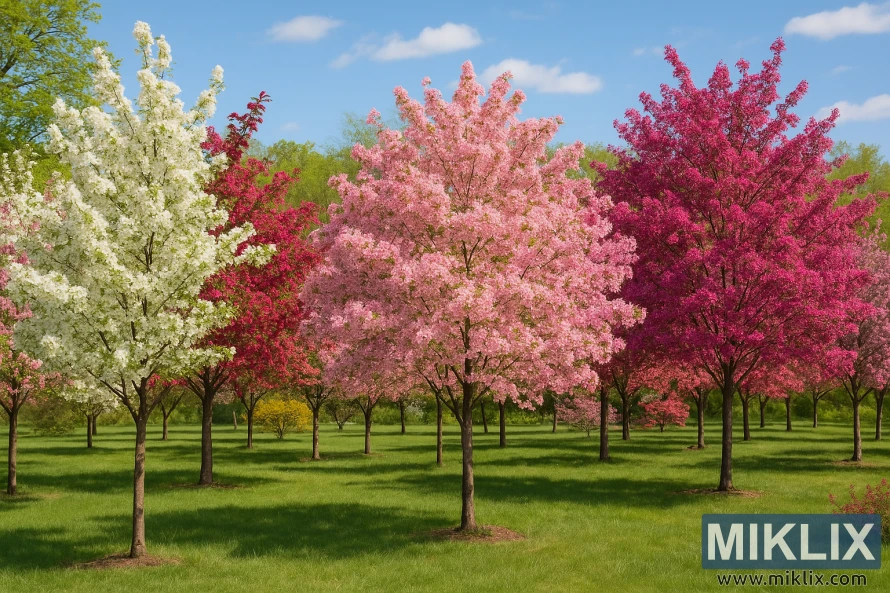
Four-Season Garden
Design a garden that shines in every season by selecting crabapples with multiple seasonal features. Varieties like Sugar Tyme offer white spring flowers, clean summer foliage, bright fall fruits that persist into winter, and interesting branch structure when dormant.
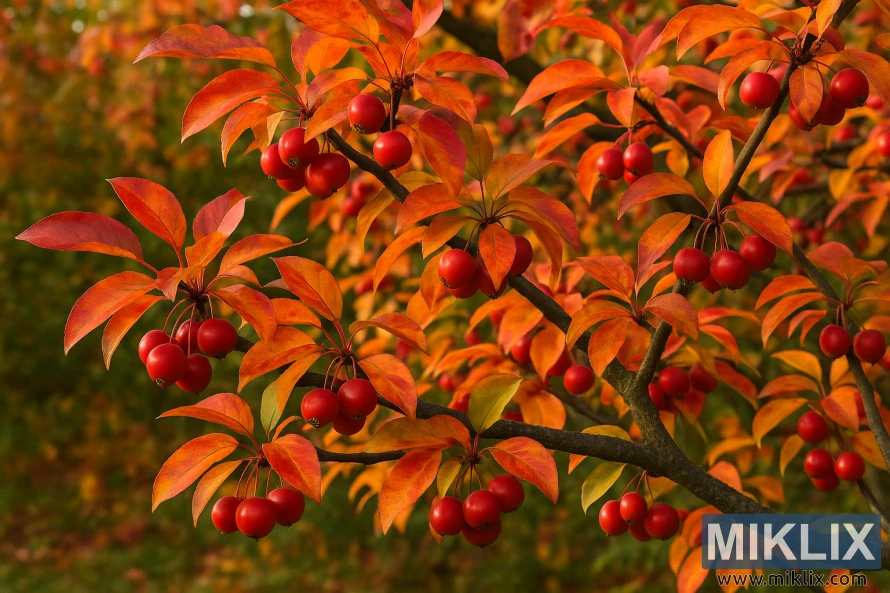
Final Recommendations: Choosing the Perfect Crabapple for Your Needs
With so many excellent varieties available, selecting the right crabapple for your specific situation can seem challenging. Here are our top recommendations based on common garden needs:
For Small Spaces
- Sargent - Naturally dwarf (8-10' tall) with horizontal spread
- Adirondack - Narrow, upright form (10-12' wide) for tight spots
- Coralburst - Very compact (10-15' tall/wide) with double pink flowers
- Tina - Ultra-dwarf Sargent selection (5' tall) for tiny gardens
For Disease Resistance
- Royal Raindrops - Excellent resistance to all major diseases
- Prairiefire - Outstanding scab resistance, good fire blight resistance
- Donald Wyman - Proven disease resistance over decades
- Sugar Tyme - Highly resistant to common crabapple diseases
For Wildlife Gardens
- Sargent - Small persistent fruits favored by birds
- Red Jewel - Bright red fruits persist through winter
- Sugar Tyme - Abundant fruits attract diverse bird species
- Harvest Gold - Unusual yellow fruits offer variety for wildlife
With so many outstanding varieties available, there's a perfect crabapple for every garden situation.

Conclusion
Crabapple trees represent one of the best investments you can make in your landscape, offering multiple seasons of interest while requiring relatively little maintenance when you select disease-resistant varieties. From the spectacular spring flower display to the colorful fruits that persist through winter, these versatile trees bring beauty and wildlife value to gardens of all sizes.
By considering factors like mature size, flower color, fruit characteristics, and disease resistance, you can select a crabapple variety that perfectly suits your specific garden needs and conditions. Whether you choose a compact Sargent for a small space, a purple-leaved Royal Raindrops for dramatic foliage color, or a wildlife-friendly Sugar Tyme with persistent fruits, you'll enjoy years of beauty from these outstanding ornamental trees.
Remember that proper planting and minimal ongoing care will ensure your crabapple thrives for decades, making it a worthwhile addition to any garden landscape. With the information provided in this guide, you're well-equipped to select, plant, and care for the perfect crabapple tree for your garden.
Further Reading
If you enjoyed this post, you may also like these suggestions:
- A Guide to the Best Varieties of Weeping Cherry Trees to Plant in Your Garden
- Best Beech Trees for Gardens: Finding Your Perfect Specimen
- A Guide to the Best Varieties of Magnolia Trees to Plant in Your Garden
